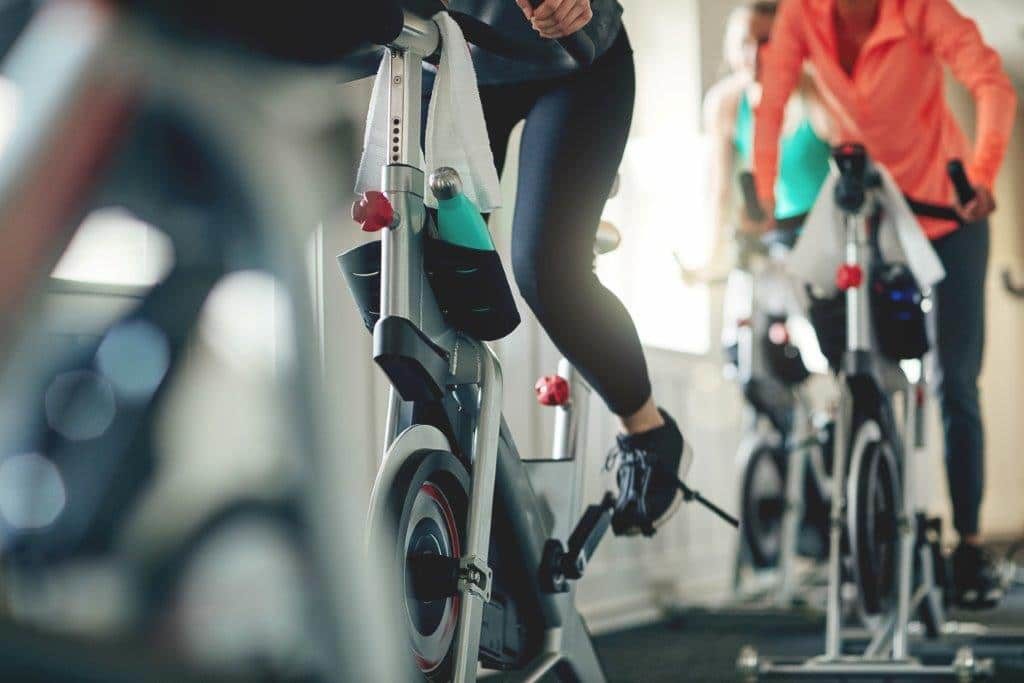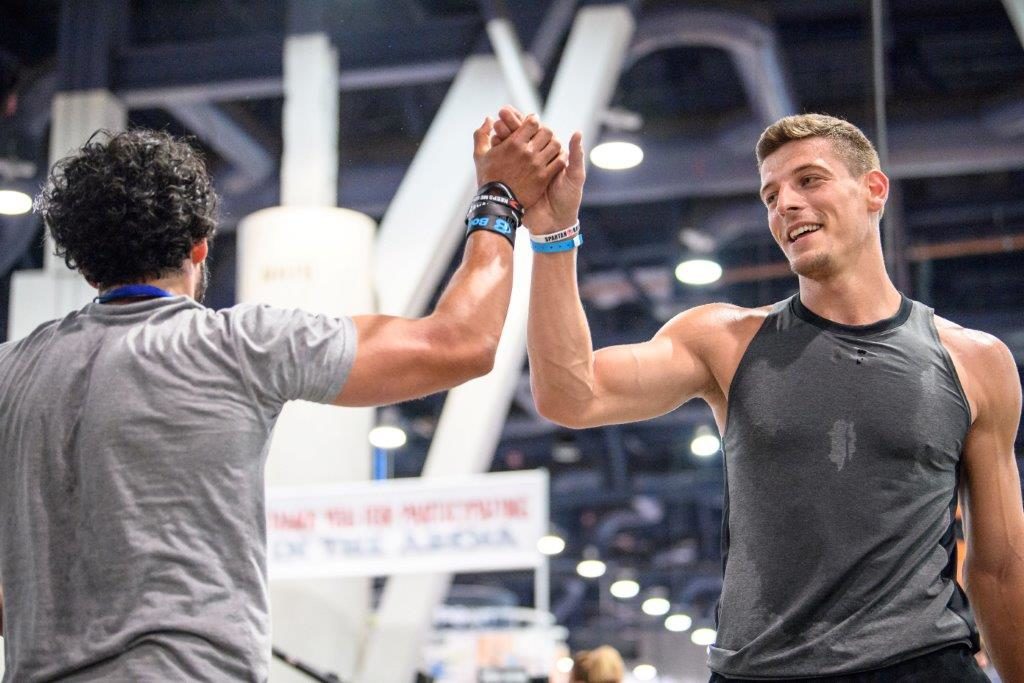Dance Fitness for Older Adults
Older adults will reap myriad mind-and-body benefits—long after they sashay out of your classroom.
Dance-based fitness classes are resurging faster than a high tide. And they are loaded with benefits far beyond the physical, especially for older adults. Combine these scientific study results with our targeted teaching tips to ride this wave in high style across the fitness dance floor.
First Things First: Are You Prioritizing Moves or Movement?
First, it helps to determine the type of dance-fitness class to offer. These classes fall into two basic categories: ones that focus on the choreography and ones that focus on the cardiovascular component. In short, does your dance class focus on specific moves or stylized movement? Which is more important: performance or participation?
Dance Fitness Choreography and Performance
Is your goal to teach older adults a specific combination or technique—one they memorize and polish to some degree? Such a class involves stops and starts to address each new step. The primary objective is for participants to learn the choreography, perhaps progressing from half-time to tempo (or from part to whole) as participants master a series of steps. Perhaps the same song is repeatedly played as moves match the music. While the “sweat” factor may be low to medium, the learning aspect is high, even if intensity rises and falls. The result might be a short, 32- or 64-count combo, which everyone performs at the end of class.
Cardio and Participation
With cardio dance classes, the workout is the focus, with dance moves as a means to that end. Whether or not participants mimic the teacher’s choreography, they keep moving to keep their heart rate in the aerobic zone. Music is continuous and varied, though the beats per minute may be constant. The combo might offer options, such as walk or turn, step-touch or shimmy, arms freestyle or coordinated with the legs.
Of course, dance-fitness classes can range anywhere within these two categories, and you can mix and match within the session or from one session to another.
Which Is Best for Older Participants?
The bigger question is whether one approach is better than another for aging bodies. Performance or participation? Choreo or cardio? What do studies reveal? And does a particular dance style offer more benefits than another? Do you “go, go, go” with disco, or choose country line dancing, hip-hop, partnerless swing, ballroom or folk dance? Do your participants benefit more from tap dancing, Broadway or burlesque-style moves?
See also: 3 Ways to Rock Group Fitness
Science Says: “It’s (Almost) All Good!”
The extremely good news is that study after study confers a bow and applause to almost all dance-based sessions directed to older adults. The key is to provide movements that are achievable for them. If the choreography requires abilities and intricacies beyond their reach or if they are compared unfavorably to younger people learning the same routines, they are reminded of their aging bodies and diminished capacity (Heikkinen & Wilinska 2022).
If, instead, the moves and combinations are pain-free—and easy to follow or memorize—then almost any type of dance brings joy and a host of benefits, including those that follow.
Physical and Physiological Benefits of Dance Fitness
Let’s start with the best known and most apparent benefits to dancing bodies, especially aging ones: the physical and physiological ones. Dance classes confer many of the same pulmonary and heart benefits as traditional cardio exercises. Injury risk is low, given the less-repetitive aspect, compared with other cardio activities. Agility, balance, bone mass stimulation, flexibility and endurance are all improved via dance (Because 2022; Bethesda 2021; Keogh et al. 2009; Hwang & Braun 2015). In fact, Merom, Ding and Stamatakis (2016) reported that older adults who danced regularly had a 46% lower risk of dying from heart disease than those who rarely or never danced.
Cognitive Benefits of Dance Fitness
Dancing can maintain or improve cognitive skills in healthy older adults. As little as 1–2 hours of dance per week bolsters brain health via multisensory stimulation, social interaction and learning movement patterns (Predovan et al. 2019; Rossetti 2018).
Memorizing choreography increases brain activity, thereby promoting better cognitive function (Bethesda 2021; Edwards 2015). Dancing also increases neural connectivity because it integrates several brain functions at once, such as the kinesthetic, rational, musical and emotional, and it stimulates regions involved in executive function, long-term memory, and spatial recognition (Hewston et al. 2021; Xi Hu et al. 2021).
Regarding dementia: In a study examining the effects of 11 types of physical activity (including cycling, golf, swimming, tennis and dance), researchers found that only dance lowered the risk of this debilitating disease (Verghese et al. 2003).
See also: 5 Top Trends in Older-Adult Fitness
Balance and Fall Prevention Benefits
Dance-based activities—such as folk dancing, ballroom dancing and tai chi (a sort of slow-motion dance)—have been shown to reduce both fall risk and actual falls in older adults by 37% and
31%, respectively (Mattle et al. 2020).
One theory: Because dance requires your base of support to change with each move, step and turn, the brain and body respond by enhancing the ability to adjust and maintain balance during movement. These balance demands may carry over to non-dance-related (everyday) activities, thus helping people react faster to prevent a fall when stepping off a curb, for instance (Bethesda 2021; Rossetti 2018).
Emotional Benefits of Dance Fitness
Dancing is also a creative activity that can lift participants’ mood, reduce stress and release negative emotions. Modes such as aerobic dance, ballroom dancing and social dancing, as well as dance movement therapy, improve mood and lower depression (Crumbie et al. 2015). Above and beyond the research, the benefits are evident from the joy on participants’ faces. It’s good news that these types of classes are now offered in retirement communities (Chartwell 2023).
Because dance-fitness classes typically synchronize movement with music, they offer a pleasure double play. Music stimulates the brain’s reward centers, while dance activates its sensory and motor circuits (Edwards 2015). That show tune or Motown oldie is posited to trigger the chemical dopamine, which affects happiness and well-being, as well as movement and thinking.
Dance also raises levels of the feel-good hormone serotonin (Edwards 2015). Given the concerns older adults express about maintaining brain health, fitness dance classes may be one of the most beneficial and fun ways to reach this goal (Rossetti 2018).
Expert Insights on Dance Fitness for Older Adults
Armed with all these positive research results, what can you do to appeal to older people and offer appropriate dance-fitness classes for aging bodies? Experienced dance-fitness teachers Connie Bennett, cardio department coordinator for Rancho la Puerta Fitness Resort in Tecate, Mexico, and Megan Merchant, MS, NBC-HWC, a fitness pro and health educator for over two decades based in Albuquerque, New Mexico, share their insights.
Keep an open mind. Bennett states up front that “age has not usually been a factor in (determining my choreography). I’ve had well-conditioned 80-year-olds who can keep up with the fast-twitch, quick moves without breaking a sweat, while deconditioned 20-year-olds in the same class are lost and winded. This experience has taught me to step back from assuming that the biological age of my students will determine the type of dance class I’ll be teaching that day.”
Adjust for injuries. Merchant shares that participants’ pains and injuries shape her movement choices: “When I first began teaching older adults in 2001, I had a set idea of what I wanted to teach. No kidding, at the end of Day 1, I had a very generous student approach me to say, ‘That move you did? I can’t do that.’ She had a rotator cuff injury and frozen shoulder. I set out to find every ‘can’t do’ move that participants mentioned, and I created ‘can do’ options and variations. My class rapidly grew from 10 to 40 to 80 (dancers).”
Look, listen and ask questions. For Bennett, the “warmup is a fact-finding mission. If I discover a particularly well-conditioned group, I include the fast-twitch crossover moves. If the group is a bit more frail, I leave out the quick, complicated moves and stick to the slower, straightforward stuff. Minimize fear and maximize fun: That’s my goal.” For Bennett, the workout and enjoyment take precedence over the choreography and technique.
“Ask questions one-on-one to hone class content,” advises Merchant. “Observe and listen intently; take action on the feedback participants share by integrating enhancements into each next class.”
Reduce their inhibitions. One approach Bennett has used successfully to inspire older adults to engage in dance more easily? Have participants face away from the mirror at first. “My favorite dance forms—African dance and hip-hop—require lots of hip action. I’ve found that turning participants away from the mirror relaxes them and allows them to wiggle freely without being self-conscious or embarrassed.” Once they have practiced a bit, Bennett flips them around to face the mirror. She does this for each block of moves—turning away from the mirror, then back toward it—to build their confidence with each progression.
Start cuing sooner. Because Bennett’s classes are mostly older adults, she gives more lead time with her cues. Instead of signaling a change on the 6th or 7th count prior to the upcoming 8 count, she cues a full 8 counts before moving to the next step. She finds that if her dancers “hear the info on count 1, then they are ready to (change) by count 8.”
Make moves easier to remember. Bennett suggests dance-fitness instructors “give the moves names that can be associated with easily relatable things such as the Jed Clampett, the Temptations or the rocking horse.”
Describe and demonstrate. Merchant uses what she calls “dynamic energy cues.” She packages verbal and nonverbal cues, giving mini movement demos that exemplify “light versus heavy (energy) or sudden versus sustained speed. I show the class one move as ‘light and free’ and the same move as ‘heavy and bound,’ flipping the energy to the opposite end of the spectrum.”Explore the definition of dance. Merchant notes that there are many ways to define dance: fine arts, social, fitness, competitive, etc. “Yet all dances originate from a passionate trigger (war/peace, victim/victor, fear/bravery, constraint/freedom, loneliness/connection, distress/eustress, hate/love),” she says. “If you 1) seek to understand what your current participants desire beyond fitness, 2) study the plethora of cultural and (historical) dance options available, and 3) use your fitness wisdom to teach safe and health-elevating movement experiences, you will change not only bodies, but minds, emotions, relationships and communities. This level of work and love, finding meaning in movement, and applying it to heal and strengthen people is worth every moment.”
8 Tips for Teaching Dance-Based Fitness Classes to Older Adults
Insights from Kymberly Williams-Evans, MA:
- Keep beats per minute in the 118–135 range.
- Offer primarily low-impact, non-propulsive, joint-friendly moves. (If you integrate leaps, jumps, drops or fast turns, for example, present them as an option, not as the default.)
- Depend heavily on visual cues in case you have participants with hearing issues.
- Repeat moves and keep combos simple. A final routine not exceeding 128 counts allows for participants’ success.
- Cue participants to “do their own thing” or simply move their arms if they don’t like (or recall) the footwork.
- Skip any choreography that goes to the floor and back up. Heads should stay above hearts, as you will likely have people with blood pressure issues, and vertical changes can cause dizziness.
- Older adults like many music styles, not just oldies, so select modern songs along with your classics.
- Prioritize the joy of movement over choreography. If ever a workout mode was destined for fun and joy, it’s a dance-based one!
A Few of My Favorite Cues!
- Your heart rate does not know if your feet match mine, so don’t worry about the exact steps.”
- Tell a story—with your face, your feet, your arms.”
This class is about having fun, not about perfection. Perfection is highly overrated.”
References
Because. 2022. 10 Benefits of dance exercise for seniors + how to start. Accessed Feb. 19, 2023: becausemarket.com/blogs/news/health-benefits-of-dancing-for-seniors.
Bethesda. 2021. 12 Health benefits of dancing for seniors. Health & Wellness, Accessed Feb. 19, 2023: bethesdahealth.org/blog/2021/10/27/12-health-benefits-of-dancing-for-seniors/.
Chartwell. 2023. 7 health benefits of dance for seniors. Accessed Mar. 13, 2023: chartwell.com/en/blog/2021/05/7-health-benefits-of-dance-for-seniors.
Crumbie, V., et al. 2015. The impact of dance interventions on mood and depression in older adults. Therapeutic Recreation Journal. Accessed Mar. 13, 2023: https://leftylexi.files.wordpress.com/2015/11/dancemood.pdf.
Edwards, S. 2015. Dancing and the brain. Harvard Medical School. Accessed Feb. 19, 2023: hms.harvard.edu/news-events/publications-archive/brain/dancing-brain.
Heikkinen, S., & Wilinska, M. 2022. Dancing my age: Emotions, interactions, and bodily sensations. Frontiers in Sports and Active Living. Accessed Feb. 19, 2023: doi.org/10.3389/fspor.2022.804888.
Hewston, P., et al. 2021. Effects of dance on cognitive function in older adults: A systematic review and meta-analysis. Age and Ageing, 50 (4),1084–92.
Keogh, J.W.L., et al. 2009. Physical benefits of dancing for healthy older adults: A review. Journal of Aging and Physical Activity, 17 (4), 479–500.
Mattle, M., et al. 2020. Association of dance-based mind-motor activities with falls and physical function among healthy older adults: A systematic review and meta-analysis. JAMA Network Open, 3 (9), e201768.
Merom, D., Ding, D., & Stamatakis, E. 2016. Dancing participation and cardiovascular disease mortality. American Journal of Preventative Medicine, 50 (6), 756–60.
Predovan, D., et al. 2019. Effects of dancing on cognition in healthy older adults: A systematic review. Journal of Cognitive Enhancement, 3, 161–67.
Rossetti, H. 2018. Ballroom to boogie: How dancing can improve seniors’ brain health. UT Southwestern Medical Center. Accessed Feb. 19, 2023: utswmed.org/medblog/dancing-exercise-keywords/.
Verghese, J., et al. 2003. Leisure activities and the risk of dementia in the elderly. The New England Journal of Medicine, 348, 2508–16.
Hwang, P.W-N., & Braun, K.L. 2015. The effectiveness of dance interventions to improve older adults’ health: A systematic literature review. Alternative Therapies in Health and Medicine, 21 (5), 64–70.
Xi Wu, V., et al. 2021. The effect of dance interventions on cognition, neuroplasticity, physical function, depression, and quality of life for older adults with mild cognitive impairment: A systematic review and meta-analysis. International Journal of Nursing Studies, 122, (104025).
Kymberly Williams-Evans, MA
Kymberly Williams-Evans, PhD (ABD) has been a fitness professional on four continents, in four languages, for four decades on land, at sea and across the airwaves. After years of co-hosting an online radio program (Active Aging for BoomChickaBoomers), she reports having interviewed scads of great guests and two really bad ones.






